

Maesters. From A Wiki of Ice and Fire Maester links, Art by Tim Durning ©
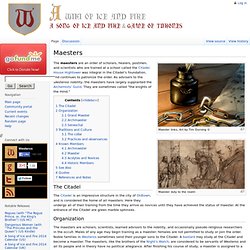
Redefining Spirituality for Our Rapidly Changing World. The Evolution of Enlightenment. In response to my recent post, "The Bright Side of Globalization," my friend and colleague Jean Houston sent me an excerpt from her book Jump Time entitled, "Wok and Roll in the Rainbow World," on a similar theme.

It's a true adventure into the multidimensional, interwoven creative complexity of the emerging new world that we are basking in. The article is quite long, so I’ve published only my favorite excerpt from the piece here called, “Fusion Food,” in which Jean expounds in the most creative way imaginable on the relationship between eating, cooking, and thinking globally. Fusion Food: An Excerpt from Jump Time. Bhutan To Be First Country to Go 100% Organic. If there was ever a nation that could see the purpose behind organic, sustainable farming, it would be a nation that is composed mostly of farmers.
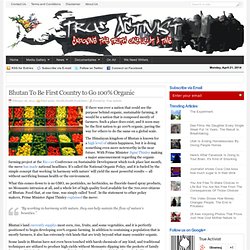
Such a place does exist, and it soon may be the first nation to go 100% organic, paving the way for others to do the same on a global scale. The Himalayan kingdom of Bhutan is known for a high level of citizen happiness, but it is doing something even more noteworthy in the near future. With Prime Minister Jigmi Thinley making a major announcement regarding the organic farming project at the Rio+20 Conference on Sustainable Development which took place last month, the move has made national headlines. It’s called the National Organic Policy, and it is fueled by the simple concept that working ‘in harmony with nature’ will yield the most powerful results — all without sacrificing human health or the environment. Sovereign state. Member states of the United Nations, all of which are sovereign states.
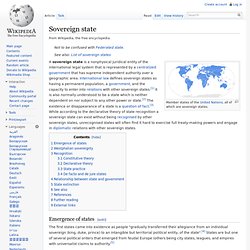
A sovereign state is a nonphysical juridical entity of the international legal system that is represented by a centralized government that has supreme independent authority over a geographic area. International law defines sovereign states as having a permanent population, a government, and the capacity to enter into relations with other sovereign states.[1] It is also normally understood to be a state which is neither dependent on nor subject to any other power or state.[2] The existence or disappearance of a state is a question of fact.[3] While according to the declarative theory of state recognition a sovereign state can exist without being recognised by other sovereign states, unrecognised states will often find it hard to exercise full treaty-making powers and engage in diplomatic relations with other sovereign states.
Emergence of states[edit] Westphalian sovereignty[edit] Collapse:_How_Societies_Choose_to_Fail_or_Succeed.pdf. Untitled - pan15s.pdf. Kaiseki. Kaiseki consists of a sequence of dishes, each often small and artistically arranged Kaiseki (懐石?)

Or kaiseki-ryōri (懐石料理?) Is a traditional multi-course Japanese dinner. The term also refers to the collection of skills and techniques that allow the preparation of such meals, and are analogous to Western haute cuisine.[1] There are basically two kinds of traditional Japanese meal styles called kaiseki or kaiseki-ryōri. Origin[edit] Metonic cycle. Heliocentric Solar System For astronomy and calendar studies, the Metonic cycle or Enneadecaeteris (from Ancient Greek: ἐννεακαιδεκαετηρίς, "nineteen years") is a period of very close to 19 years that is remarkable for being nearly a common multiple of the solar year and the synodic (lunar) month.
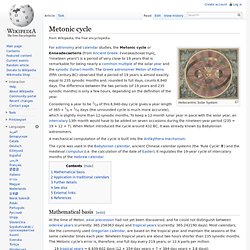
The Greek astronomer Meton of Athens (fifth century BC) observed that a period of 19 years is almost exactly equal to 235 synodic months and, rounded to full days, counts 6,940 days. The difference between the two periods (of 19 years and 235 synodic months) is only a few hours, depending on the definition of the year. Revisiting Limits to Growth: Could the Club of Rome Been Correct - ov-simmons,club_of_rome_revisted.pdf. EMS ExSum Cover AA - limitstogrowth.pdf. The Limits to Growth. Five variables were examined in the original model.
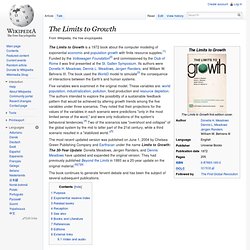
These variables are: world population, industrialization, pollution, food production and resource depletion. The authors intended to explore the possibility of a sustainable feedback pattern that would be achieved by altering growth trends among the five variables under three scenarios. They noted that their projections for the values of the variables in each scenario were predictions "only in the most limited sense of the word," and were only indications of the system's behavioral tendencies.[4] Two of the scenarios saw "overshoot and collapse" of the global system by the mid to latter part of the 21st century, while a third scenario resulted in a "stabilized world.
The Ecologist archive: Vol. 2 No. 1, January 1972. The Ecologist archive: Preface: A Blueprint for Survival. A Blueprint for Survival occupied the entire issue of The Ecologist Vol. 2 No. 1, January 1972, in advance of the world's first Environment Summit: the 1972 UN Conference on the Human Environment, in Stockholm.

The principal authors were Edward Goldsmith and Robert Allen, with additional help from Michael Allaby, John Davoll, and Sam Lawrence. So great was demand for A Blueprint for Survival that it was republished in book form later that year by Penguin Books, on 14 September 1972. This document has been drawn up by a small team of people, all of whom, in different capacities, are professionally involved in the study of global environmental problems. Four considerations have prompted us to do this:
Blueprint for Survival. A Blueprint for Survival was an influential environmentalist text that drew attention to the urgency and magnitude of environmental problems.
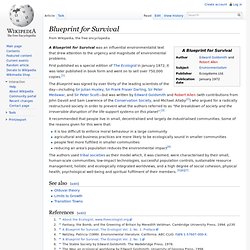
First published as a special edition of The Ecologist in January 1972, it was later published in book form and went on to sell over 750,000 copies.[1] The Blueprint was signed by over thirty of the leading scientists of the day—including Sir Julian Huxley, Sir Frank Fraser Darling, Sir Peter Medawar, and Sir Peter Scott—but was written by Edward Goldsmith and Robert Allen (with contributions from John Davoll and Sam Lawrence of the Conservation Society, and Michael Allaby[2]) who argued for a radically restructured society in order to prevent what the authors referred to as “the breakdown of society and the irreversible disruption of the life-support systems on this planet”.[3] It recommended that people live in small, decentralised and largely de-industrialised communities.
Some of the reasons given for this were that: See also[edit] References[edit] Didgeridoo. There are no reliable sources stating the didgeridoo's exact age.

Archaeological studies of rock art in Northern Australia suggest that the people of the Kakadu region of the Northern Territory have been using the didgeridoo for less than 1,000 years, based on the dating of paintings on cave walls and shelters from this period.[2] A clear rock painting in Ginga Wardelirrhmeng, on the northern edge of the Arnhem Land plateau, from the freshwater period[3] (that was begun 1500 years ago)[4] shows a didgeridoo player and two songmen participating in an Ubarr Ceremony.[5] Names & etymology[edit] There are numerous names for the instrument among the Aboriginal peoples of northern Australia, none of which closely resemble the word "didgeridoo" (see below). "Didgeridoo" is considered to be an onomatopoetic word of Western invention. There are numerous other, regional names for the didgeridoo.
Construction[edit] A wax mouthpiece can soften during play, forming a better seal. Sancai. Sancai (Chinese: 三彩; pinyin: sāncǎi; literally "three colours") is a type of decoration on Chinese pottery using three intermingled colors for decoration. Technique[edit] Sancai follows the development of green-glazed pottery dating back to the Han period (25-220 AD).[1] Predecessors to the sancai style can also be seen in some Northern Qi (550-577) ceramic works. Northern Qi tombs have revealed some beautiful artifacts, such as porcellaneous ware with splashed green designs, previously thought to have been developed under the Tang dynasty.[2] Such a jar has been found in a Northern Qi tomb, which was closed in 576 AD, and is considered as a precursor of the Tang sancai style of ceramics.[3]
File:Soutra du diamant ouvert.png. Get More Followers By Breaking the Rules. Finding Your Tribe May Be the Hardest Thing You Do. How To Build Your Tribe - Finding ‘Your People’ Email This is a guest post by Marelisa of Abundance Blog at Marelisa Online. One of the most fundamental human needs is the need to belong. Noted psychologist, Abraham Maslow, identified it as one of the five basic needs. We want to be part of a group and to feel loved and accepted by others. Exploring Tribal Leadership: Understanding and Working with Tribal People. Introduction Understanding and working with tribal people can be important for Extension professionals who deliver educational programming in Native American communities.
It is important for Extension to provide educational information that is research based. This article provides research-based implications and recommendations for working with Native American tribal people. The article begins with a Methodology section that provides background information about a research study completed by the author that explored indigenous tribal leadership; the tribe's history, culture, and traditions; and how it has been affected by acculturation from the dominant society. Uncontacted Tribes: The Last Free People on Earth. Deep in one of the remotest parts of the Brazilian Amazon, in a clearing at the headwaters of the Envira River, an Indian man looks up at an aeroplane. He is surrounded by kapok trees and banana plants, and by the necessities of his life: a thatched hut, its roof made from palm fronds; a plant-fiber basket brimming with ripe pawpaw; a pile of peeled manioc, lying bright-white against the rain forest earth.
The man’s body is painted red from crushed seeds of the annatto shrub, and in his hand is a long wooden arrow — held, in seeming readiness, close to its bow. At his side, children, naked but for cotton waist-bands, gaze up in amazement. Jared Diamond: what the tribes of New Guinea have to teach us. The Kaulong people of New Britain used to have an extreme way of dealing with families in mourning. Until the 1950s, newly widowed women on the island off New Guinea were strangled by their husband's brothers or, in their absence, by one of their own sons. Custom dictated no other course of action. Failure to comply meant dishonour, and widows would make a point of demanding strangulation as soon as their husbands had expired.
The impact on families was emotionally shattering, as Jared Diamond makes clear in his latest book, The World Until Yesterday. Scarification. Scarifying (also scarification modification) involves scratching, etching, burning / branding, or superficially cutting designs, pictures, or words into the skin as a permanent body modification.[1] In the process of body scarification, scars are formed by cutting or branding the skin by varying methods (sometimes using further sequential aggravating wound healing methods at timed intervals, like irritation.), to purposely influence wound healing to scar more and not scarless. Tush kyiz. Tush kyiz (Kazakh: тұс киіз, тұс — side, the edge, киіз — felt, Kyrgyz: туш кийиз [tuʃ kijíz]) are large, elaborately embroidered wall hangings, traditionally made in Kyrgyzstan and Kazakhstan by elder women to commemorate the marriage of a son or daughter. Colors and designs are chosen to symbolize Kyrgyz traditions and rural life.
Yomut carpet. Mid 19th century - Yomut ensi (door hanging) Explore the Virtual Museum of Canada (VMC) Tengrism. "Tengriism" redirects here. For the (unrelated) Japanese religion, see Tenriism. Tengrism (sometimes stylized as Tengriism), occasionally referred to as Tengrianism , is a modern term[1] for a Central Asian religion characterized by features of shamanism, animism, totemism, both polytheism and monotheism,[2][3][4][5] and ancestor worship. Historically, it was the prevailing religion of the Turks, Mongols, and Hungarians, as well as the Xiongnu and the Huns.[6][7] It was the state religion of the six ancient Turkic states: Göktürks Khaganate, Avar Khaganate, Western Turkic Khaganate, Great Bulgaria, Bulgarian Empire and Eastern Tourkia. Spiritual ecology. Nayef Al-Rodhan. Insatiable Is Not Sustainable - Douglas M. Brown.
Want to Be Happier? Stop Doing These 10 Things Right Now. Athenian democracy. Orientalism. Collaborationism. Collaborationism is cooperation with enemy forces against one's country.[1] Stanley Hoffmann subdivided collaboration onto. Aino Folk-Tales. Executive-Report-Sustainability-and-Corporate-Culture.pdf. 5 Lessons for Building a Sustainable Culture - Sustainable Waterloo Region. New Village Journal: Resources. New Village Journal: Building Sustainable Cultures.
Guantánamo Prisoner's Memoirs Offer Rare First-Person Account of Torture. Beyond Civilization: Humanity's Next Great Adventure. Science Saved My Soul. 63b9b05800e2d85c706748155fc6a1.jpg (JPEG Image, 540 × 540 pixels) Only One Way In by Keith Zoo. Rabbit by Sasita Samarnpharb. Art and Design. Sim City. Born of Clay. Native Worship in American Prisons. American Indian Quotes. 10 Beautiful Words About Love That Don’t Exist in English. The Infinity Burial Project. Waste = Food (2007. Mother Earth and Father Earth. What does it mean to immerse rather than transcend?
The Tribe. The Book of the Knife. The Life Promise. What are the Unborn Elders? What is a Prayer Promise? The Path of life. What We Protect. Type III ecosystem cartoon - Stuart McMillen comics. Waste, Recycling and Cradle to Cradle - The Red Cedar Volunteer Resource. True Cathedrals. Community - The Red Cedar Volunteer Resource. Creating Cultural Identity. Giri (Japanese) Dan Ariely: What makes us feel good about our work?
Potlatch. Ubuntu (philosophy) Change and Ritual. How do Freepath people get up in the Morning? Flag Designer. Links to Useful Lojban Resources. Want to Simplify Your Life? Try a Uniform. Kilts - UTILIKILTS. Cultural Techniques. No True Barter? On the Dangers of Complexity.